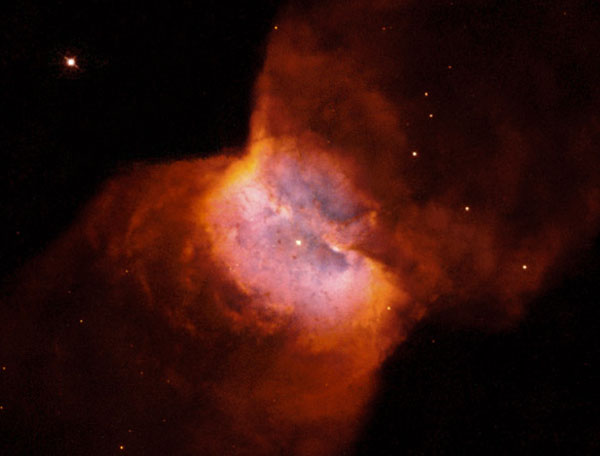
|
Credit & Copyright: Massimo Stiavelli (STScI),
Inge Heyer (STScI) et al.,
& the Hubble Heritage Team (AURA/ STScI/ NASA)
Explanation:
It may look like a butterfly, but it's bigger than our
Solar System.
NGC 2346 is a
planetary nebula made of gas and
dust
that has evolved into a
familiar shape.
At the heart of the
bipolar planetary nebula
is a pair of close stars orbiting each other
once every sixteen days.
The tale of how the butterfly blossomed probably
began millions of years ago, when the stars were farther apart.
The more massive star expanded to encompass its
binary companion,
causing the two to spiral closer and expel
rings of gas.
Later, bubbles of hot gas emerged as the core of the massive
red giant star became uncovered.
In billions of years, our Sun will become a
red giant and emit a
planetary nebula - but probably not in the shape of a
butterfly, because the
Sun has no binary star companion.
& the Hubble Heritage Team (AURA/ STScI/ NASA)
|
January February March April May June July August September October November December |
| ||||||||||||||||||||||||||||||||||||||||||||||||
NASA Web Site Statements, Warnings, and Disclaimers
NASA Official: Jay Norris. Specific rights apply.
A service of: LHEA at NASA / GSFC
& Michigan Tech. U.
Based on Astronomy Picture
Of the Day
Publications with keywords: planetary nebula - NGC 2346 - butterfly nebula
Publications with words: planetary nebula - NGC 2346 - butterfly nebula
See also:
- APOD: 2025 April 15 Б Planetary Nebula NGC 1514 from Webb
- Planetary Nebula Abell 7
- The Medusa Nebula
- Jones Emberson 1
- APOD: 2024 February 12 Б HFG1 & Abell 6: Planetary Nebulae
- APOD: 2023 December 24 Б NGC 2440: Cocoon of a New White Dwarf
- APOD: 2023 October 3 Б MyCn 18: The Engraved Hourglass Planetary Nebula
